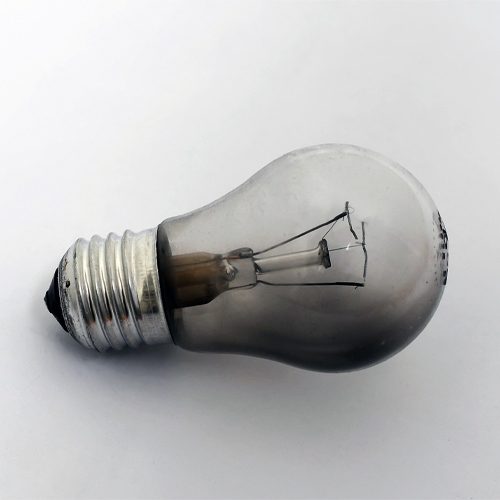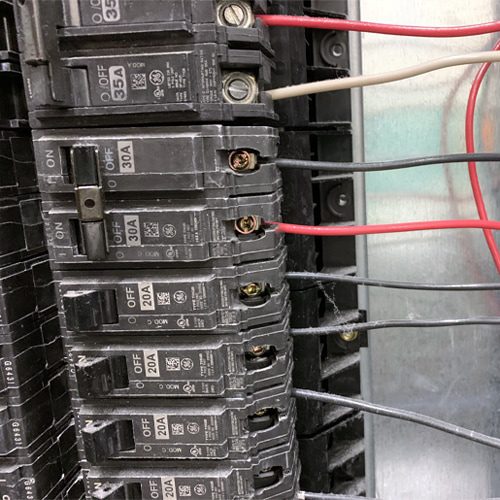10 Common Household Electrical Problems and How to Fix Them
A lot of people experience an electrical issue and don’t know what to do about it. Even worse, you might have electrical problems and think they’re normal. Our team of experienced electricians has seen it all. We want to outline some home electrical problems and help you out.
10 Common Household Electrical Problems
In our 15 years in business, we’ve seen a lot of electrical issues in people’s homes. We thought that it would be a good idea to put together some of the most common electrical problems in a single list.
We’ll do our best at outlining what the problem is, how dangerous it is, how to diagnose electrical problems, and what you can do about it. If you’re ever unsure or uneasy about the solution, you can always reach out to us and we’ll send a professional electrician over to your house. Let’s get started!
1: Lights Switch Not Working
The problem: A light switch is unreliable, doesn’t turn on your light when you click it on, or a dimmer doesn’t dim the lights.
Danger level: Low. Could be due to defective parts, a mistake in installation, or the age of the switch.
Troubleshooting: This electrical issue can be due to different factors. First, make sure the light bulb works by trying it in another light fixture. Make sure the circuit breaker is “on” and test an outlet near the light switch to see if power is going to the circuit. Does your dimmer work at any setting or not at all?
Solution: To keep you safe, you might want to call a professional electrician if a switch isn’t working. Even though the danger level is low, the solution itself is dangerous – we don’t want to see you get hurt.
2: Lots of Electrical Surges
The problem: You notice frequent power surges in your house. A surge is when the power turns off or fades for a moment before coming back on.
Danger level: Moderate. Surges over time can damage electronic devices on your grid.
Troubleshooting: Be on the lookout for surges around the house. Most surges occur across your entire grid. Surges aren’t specific to a single room. Surges can be expected during lightning storms, but otherwise shouldn’t occur.
Solution: The only solution is to bring in a professional electrician for an inspection. A professional can take a look at your grid and the wiring in your home to find a culprit. There might be a faulty device or powerboard connected to your grid somewhere.
3: Circuit Breaker Tripping
The problem: You sporadically lose power to an area of your home.
Danger level: High. Often due to overloading a circuit.
Troubleshooting: Notice when the breaker trips. Is it immediately after starting a device, or when your HVAC system turns on?
Solution: Try unplugging some devices and see if that works. You might need to upgrade your electrical system or add a circuit to your home. In either case, you’ll need the help of a professional electrician.
4: Outlets or Switches are Warm
The problem: Outlets or light switches are warm to the touch.
Danger level: Very high. This could be indicative of a serious electrical problem that can cause fires.
Troubleshooting: Troubleshooting electrical problems is usually hard, but not in this case. If you touch a light switch or outlet and it’s warm, that’s all you need to know. Hot light switches or warm outlets means you have a problem. Another way to know: if you smell a fishy smell near an outlet, check to see if it’s warm.
Solution: Immediately turn off the breaker to that outlet or switch and call an electrician. Refrain from using that switch or outlet until the electrician arrives to help.
5: Lights Too Dim or Too Bright
The problem: The lights in your home are either too bright, too dim, or they flicker between levels of intensity.
Danger level: High. This could be due to a poor connection in the socket. It can cause arcing, sparking, or a fire.
Troubleshooting: First, make sure you have the right lightbulbs for the outlets. If you look in the light socket, there should be a sticker nearby that tells you the maximum allowable wattage.
The bulbs should have their wattage printed on the bulb. Ensure the bulb’s wattage is no higher than the printed max wattage on the socket.
Next, make sure that the lightbulbs are screwed in all the way. If the problem persists, try using a new lightbulb — sometimes lightbulbs are defective, or the manufacturer made a bad batch.
Is the problem happening in multiple rooms or just one? If it’s happening in multiple rooms, that usually points to defective lightbulbs. If it only occurs in a single room, that usually means a poor socket connection.
Solution: If none of the troubleshooting steps work, you probably have defective connections in your socket. Call a professional electrician to check it out.
6: Electrical Shocks
The problem: You feel a mild shock when you plug in or turn on a device.
Danger level: Moderate to very high. It could either be a faulty appliance or faulty wiring.
Troubleshooting: Since this could be due to faulty wiring, there is no safe way to troubleshoot this problem. If you just experienced an electrical shock, then call a professional electrician.
Solution: In this case, your safest option is to contact a professional electrician.

7: Bulbs Burning Out Quickly
The problem: Brand new lightbulbs in your home are dying too quickly. Light bulbs are rated for a certain number of hours that they should work — sometimes over 40,000 hours!
Danger level: Potentially high. It could be a loose connection in the circuit or socket causing these blowouts.
Troubleshooting: Make sure that the bulbs have the right wattage for the sockets they’re going into. There will be a printed label near the socket that says the max wattage.
If your socket is rated for 60W and you’re putting a 100W bulb in, you can expect they’ll blow out quickly. If the bulb has the correct wattage and it still burns out quickly, then the culprit is probably the socket.
Solution: The solution is pretty dangerous to an untrained person. We suggest you reach out to a professional electrician for home repairs.
8: Electric Bill is High
The problem: Your electric bill is higher than normal or much higher than it should be.
Danger level: Low or high. It could be as mild as an appliance that uses a lot of energy. Alternatively, it could be due to damaged circuits or wiring issues which can cause a fire and sparks.
Troubleshooting: If this is the first month that the bill is high, try to think about what you did differently. If it’s the first hot month of the year, then you can expect your bill to go up as you use more air conditioning around the house.
If it’s a random and unexpected spike, or your bill is consistently higher than normal, then that’s another problem. You might be getting overcharged by your electricity provider, or you have a serious electrical problem in your house.
Solution: For random spikes or a consistently high electric bill, there are a few solutions:
- Fix your hot water system if there’s a leak
- Unplug chargers, electronic devices, and appliances when not in use
- Have an electrician inspect and fix your outlets and wiring
- Change your electric provider to a less expensive option
- Find out what appliances are causing your bill to go up
- Contact your electricity provider to ask about your bill
9: Light Bulb Really Hot
The problem: The light bulb is really hot to the touch. This is called “overlamping”.
Danger level: High. The heat can burn insulation and cause wiring problems in the fixture. The result could be arcing, sparks, or fires. On top of that, the damage to the socket will persist.
Troubleshooting: If the base of the light bulb is visible, take a look at it. If there are black streaks or soot along the base or on the bulb, you’re overlamping.
Put a temperature probe (a meat thermometer or equivalent) against the bulb or feel the air near the bulb. If the bulb itself is really hot, this is another indication that your socket is overlamped.
Solution: The most common problem is that your light bulb has a higher wattage than your socket allows. Notice a recurring theme here?
Ensure that the printed wattage on your light bulb is equivalent to or less than the printed max wattage on the light socket. If you’re not sure or your house is older, stick with bulbs at or below 60 watts.
If damage was done to your socket due to overlamping, then you’ll have to bring in a pro.
10: Plug Falls Out of Wall Outlet
The problem: A common problem in older houses is when a plug just won’t stay in the wall outlet. There are contacts in the outlet that should snugly hold any plug that goes in. When plugs fall out, that means the contacts are no good.
Danger level: Very high if unresolved. The outlet can arc and ignite nearby dust and wood, causing a fire.
Troubleshooting: The troubleshooting process is pretty straightforward. Plug in an electronic device. If the plug is loose or falls out, try it in another outlet. If it’s firm in another outlet, then the first outlet has faulty contacts.
Solution: Simply buy a new outlet and replace it. In our experience, a lot of homeowners feel comfortable doing this project on their own. The part only costs a few bucks, so it’s not a huge investment.
Pro tip: Make sure you turn off the outlet’s power from the circuit breaker before trying the solution.
Conclusion
At this point, you have some good information for tackling many home electrical problems that might occur. Whether or not your problem is on this list, we can help. We’ll answer any questions you may have and send an expert electrician to your house as soon as possible. Call or email us today.

